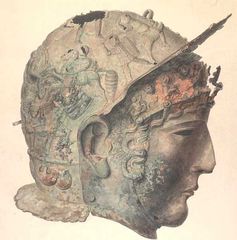Rescue of Completed Archaeological Projects (RECAP)
Historic England, 2009. https://doi.org/10.5284/1106891. How to cite using this DOI
This work is licensed under a Creative Commons Attribution 4.0 International License.
Primary contact
Historic England
4th Floor, Cannon Bridge House
25 Dowgate Hill
London
EC4R 2YA
Tel: 020 7973 3700
Resource identifiers
- ADS Collection: 1588
- DOI:https://doi.org/10.5284/1106891
- How to cite using this DOI
RescuE of Completed Archaeological Projects (RECAP)
English Heritage, 2009
Introduction to RECAP
 Roman cavalry helmet from Ribchester. Image from the Society of Antiquaries Catalogue of Drawings & Museum Objects
Roman cavalry helmet from Ribchester. Image from the Society of Antiquaries Catalogue of Drawings & Museum Objects
There are a number of completed projects from the last decade, some of international importance, which have created significant amounts of digital information. In many cases with older projects, the adoption of computer recording may only have been possible during the later analysis stages of these projects. If such data sets survive in a readily useable condition they could still constitute a major digital resource for online dissemination if the necessary work can be identified and carried out to make them available.
Because of the time-lapse since completion of these projects, it is not possible to decide on which projects might have appropriate digital material without first carrying out a degree of digital archive assessment and auditing. The RECAP project therefore proposed that a relatively speedy audit process be carried out to assess the state of existing archives from a list of projects provided by Archaeology Commissions at English Heritage.
Aims and Objectives
The overall aim of this project is to gather a sufficiently informed assessment of the existing material in order to judge the potential for archive deposition or dissemination of any digital material. In particular the project should achieve the following objectives:
- To identify and question key personnel with regard to the existence and location of digital data from each completed project.
- To locate, and as far as possible quantify any existing digital data.
- To identify the format and assess the condition of any digital data for each project.
- To make a broad assessment of the potential for archiving and dissemination, for existing data from each project.
- To assess the broad scale of work required to create a viable digital archive (including identifying any essential further digitisation work).
- To identify any other plans for dissemination and archiving of project results or references to existing project publications and archives.
- To complete a summary audit/assessment report to English Heritage setting out the current nature, condition and the potential for digital archiving and dissemination for each project. The report to include, where appropriate, cost estimates for deposition and dissemination by ADS.
Results
Archives were successfully deposited from five of the eight identified projects and are now available on line (see the site list). We believe that these five projects were 'rescued' with relative ease for two main reasons;
Data kept 'alive' by reuse. By far the most successful relationships were with MoLAS (now known as MoLA) and Oxford Archaeology (South and North). This may be due to the relative ease with which these large units could access their old data sets; both have uniform recording practises and both have single databases into which they record all excavation data. This central excavation database is constantly maintained and updated with new excavation data, therefore any 'legacy' data benefits from constant maintenance too.
Data associated with an ongoing publication programme. The datasets deposited by both MoLA and Oxford Archaeology were connected with a current publication programme, or at least one which had been undertaken in the previous two years. The data had therefore been in use in the relatively recent past in connection with the publication, staff members were familiar with it and it was easily accessible.
The final three projects (the Dover Boat, Winchester Museums and South Cadbury Castle) have not been deposited with the ADS. There are a few reasons which could explain this.
Staff changes or changes in institutional priorities. Staff changes and changes in departmental priorities at Winchester Museum Service meant that were no longer able to engage with the RECAP project. In fact, however, there was little digital data still held by the museum which had not already been used in the paper publication, as such it was felt that little would be gained by archiving the documents in digital form too.
Problems defining copyright ownership and appropriate permissions for use. Taunton Museums were unsure about the status of the copyright permissions to the South Cadbury Castle data and as such were unable to allow the formal deposit of the data with the ADS. Unlike working with the unit who had undertaken the work in the first place, trying to archive work held by a third party (Taunton Museums or Winchester Museum) holds some dangers as far as copyright clearance is concerned.
Digital archiving seen as a low priority. No digital archive was forthcoming from the Canterbury Archaeological Trust (the Dover Boat Project). This may be simply that digital archiving of this data was seen as a low priority, or other arrangements were in place to curate this data via the Dover Boat Trust who were themselves undertaking a digitisation programme at the time of the RECAP project. The Canterbury Trust site hosts some of the video clips that were to have been deposited (see http://www.canterburytrust.co.uk) and it may also have been felt that there was no need to make these videos available through the ADS website too.





